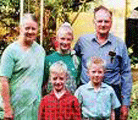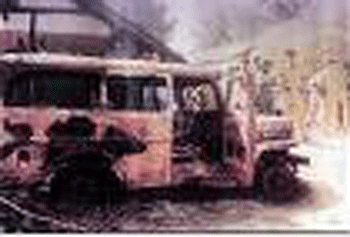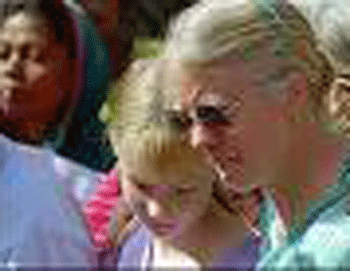 Graham Stuart Staines (1941-January 1999) was an Australian missionary who was burnt to death along with his two sons Philip (aged 9) and Timothy (aged 7) while sleeping in his station wagon at Manoharpur village in Keonjhar district in Orissa, India in January 1999. In 2003, the Hindu activist Dara Singh was convicted of leading the gang.
Graham Stuart Staines (1941-January 1999) was an Australian missionary who was burnt to death along with his two sons Philip (aged 9) and Timothy (aged 7) while sleeping in his station wagon at Manoharpur village in Keonjhar district in Orissa, India in January 1999. In 2003, the Hindu activist Dara Singh was convicted of leading the gang.
Graham Staines had been working in Orissa among the tribal poor and especially with leprosy patients since 1965.
He has been accused by Hindus of the Sangh Parivar[1] of being a zealous evangelical. While there is a perception that he converted many tribals to Christianity, the rise in Christian population in the district claimed by opponents is very slight[2].
Life history
Graham Staines was born in 1941 at Palmwoods, Queensland, Australia. He visited India in 1965 for the first time and joined Evangelical Missionary Society of Mayurbhanj (EMSM), working in this remote tribal area, with a long history of missionary activity.
Staines took over the management of the Mission at Baripada in 1983. He also played a role in the establishment of the Mayurbhanj Leprosy Home as a registered society in 1982[1]. He met Gladys June in 1981 while working for leprosy patients, and they married in 1983, and have been working together since then. They had three children, daughter Esther and two sons Philip and Timothy.
He spoke fluent Oriya and was very popular among the patients whom he used to help after they were cured. He used to teach how to make mats out of rope and basket from Saboigrass and hand weaving.[3]
Death
On the night of January 22, 1999, Graham Staines had attended a jungle camp, an annual gathering of Christians of the area to strengthen fellowship and for teaching. In the night he was sleeping in his station wagon when it was set afire by a mob. Graham and his two sons (both minors) were burnt alive.

Subsequent events
Initial investigations, conducted by the Mayurbhanj police, pointed towards the involvement of Dara Singh, the adopted name of Ravindra Pal Singh, a Hindu activist who had been active in the region since 1989. On January 29, 1999, the Government of India set up a judicial commission of inquiry under Justice D.P. Wadhwa of the Supreme Court to investigate the murder. The commission was to submit a report in two months but this was changed to 5 months in March 1999. In that same month, the case was handed over to the Central Bureau of Investigation from the state police.
In June 1999, the commission submitted its report holding Dara Singh guilty of the crime. The very next day, the CBI submitted chargesheets against the people involved. In January 2000, Dara Singh was arrested from a forest in Mayurbhanj district. In September 2000, charges were brought against the accused. Trial began in March 2001 in a district and sessions court designated a CBI court. In February 2002, an accused, Mahendra Hembram said in court that he was the sole culprit and that the others were innocent. In April 2003, accused Dayanidhi Patra said in court that he was present when Dara Singh set fire to the vehicle.
The trial ended in August 2003 and judgement was passed in September 2003 convicting Dara Singh and Hembram. In spite of Gladys Staines' appeal for clemency, Dara Singh was sentenced to death and 12 others were given life imprisonment [2].
However, the death sentence was commuted to life imprisonment in May 2005 by the Orissa High Court [4], who also acquitted the other appellants.
Gladys returned to India in June 2006, and in an interview underlined the importance of forgiveness. "In forgiveness, there is no bitterness and when there is no bitterness, there is hope. This consolation comes from Jesus Christ."[5]
On Mar 19, 2007, the Supreme Court issued notice to the CBI on a petition filed by Mahendra Hembrom challenging the Orissa High Court verdict[6], saying that his confessional statement before the trial court, in which he had said that he killed Graham Staines, should be considered in toto.
Source: Wikipedia
Graham Staines - Martyr
Australian Christian Missionary Burnt Alive With Children
Hindu (BJP, RSS, VHP) Attack On Christmas 2007 Orissa
Graham Stewart Staines: His Background
Graham Stewart Staines was born in Palmwoods, Queensland, Australia. His tryst with Mayurbhanj in the State of Orissa began in the year 1956 when he started corresponding with his pen friend Shantanu Satpathy who lived in Baripada. They used to correspond about flora and fauna of their respective countries. In 1965 Staines visited India for the first time. At the age of fifteen Staines, while still in Australia, saw the photograph of a Mayurbhanj boy Josia Soren of approximately his age with severe leprosy. This motivated Staines to come to India and work for leprosy patients..  Gladys June Staines his wife met him in 1981 while she was visiting India. Gladys says that he impressed her by his love for the people with whom he associated as well as leprosy patients. They were married in 1983. During their fifteen years of marriage their daughter Esther and their two sons Philip and Timothy were born. Gladys states in her affidavit that the children being raised in India considered India as their home. She describes Staines as a person who was faithful in whatever he did, whether it was serving leprosy patients, doing accounts, involving himself in the service of the Rotary club or caring for animals. She describes him as a loving and faithful husband and a father who was never too busy for his family. Gladys in her evidence says that Graham Staines told her that when he saw the photograph (that of Josia Soren) he was filled with sorrow and compassion for those suffering from leprosy. Because of his love for God, he decided to serve leprosy patients. She further states that he was a brilliant student gaining A's in all subjects in his board exams. In order to support his family he worked in the office of a local garage in Queensland during the day and learned accountancy at night school.
Gladys June Staines his wife met him in 1981 while she was visiting India. Gladys says that he impressed her by his love for the people with whom he associated as well as leprosy patients. They were married in 1983. During their fifteen years of marriage their daughter Esther and their two sons Philip and Timothy were born. Gladys states in her affidavit that the children being raised in India considered India as their home. She describes Staines as a person who was faithful in whatever he did, whether it was serving leprosy patients, doing accounts, involving himself in the service of the Rotary club or caring for animals. She describes him as a loving and faithful husband and a father who was never too busy for his family. Gladys in her evidence says that Graham Staines told her that when he saw the photograph (that of Josia Soren) he was filled with sorrow and compassion for those suffering from leprosy. Because of his love for God, he decided to serve leprosy patients. She further states that he was a brilliant student gaining A's in all subjects in his board exams. In order to support his family he worked in the office of a local garage in Queensland during the day and learned accountancy at night school.
Staines joined the Evangelical Missionary Society of Mayurbhanj (EMSM) and started his work in 1965. He first worked at Rairangpur in District Mayurbhanj and later shifted to Baripada (District Headquarters of Mayurbhanj) in 1983. Staines was essentially taking care of the Leprosy Home at Baripada but was also visiting churches on the invitation from local pastors where he took classes from the Bible and also classes in moral teaching. John Mathai, an evangelist with the Indian Evangelical Mission and a member of the Board of the Leprosy Home, says that Staines used to arrange speakers and take Bible studies in jungle camps.
Jungle camps as described by Gladys Staines are camps for Christians wherein people are given instructions in Bible teaching, spiritual upliftment, moral teaching and teaching on health and hygiene. Staines was fluent in Oriya, Santhali and Ho languages. In fact, Staines assisted in translating a part of the Bible into the Ho language. In his application for residence permit in India Staines describes himself as "a person involved in Missionary work and his work with the Mayurbhanj Leprosy Home and Rajabasa Leprosy Rehabilitation Farm". He also states in the said form that "he preaches the Gospel as and when time permits".
Under the head “profession or present occupation" in the application form lie states “missionary trained in carpentry metal work and motor mechanics, clerk trained in accountancy." In his application for extension of stay in India, he states that "he wishes to stay for missionary work including work with the Mayurbhanj Leprosy Home and the Rajabasa rehabilitation farm"
The EMSM to which Staines belonged was established in 1895 at the instance of the then the Maharaja of Mayurbhanj. It was first run by one Miss Kate Allenby. Staines took over the running of the Mission at Baripada only in 1983. Gladys in her evidence clarified that the Mayurbhanj Leprosy Home is a society registered under the Societies Registration Act, whereas the EMSM is a society registered in Australia. The EMSM in Australia is only a governing body for support. The Mayurbhanj Leprosy Home was registered as a society in 1982 and before that it was a part of the EMSM. A scrutiny of the accounts of the Leprosy Home was made by the Investigating Team and Sanjiv Dutta, Director FCRA was also examined. The accounts appear to have been maintained properly and nothing adverse has come to the notice of the Commission.
Staines was by all accounts a popular figure in Baripada and involved mainly with Leprosy Home and leprosy related work Balakrishnan, the District Collector of Mayurbhanj, speaks about Staines' Popularity in Baripada. Gladys says that he had a good rapport with the people of the town especially because he spoke the local language. She said that people suffering from diseases and snakebite used to come to their home in Baripada and they used to take them for treatment and these villagers would stay in the mission house. His popularity could be gauged from the massive turnout at his funeral at Baripada.
The Leprosy Home as described by Galdys Staines provides not only treatment to leprosy patients but also provides rehabilitation training in making sabai grass products and in hand weaving. It also has its own dairy farm. Staines had successfully worked to ensure that the stigma of leprosy is eradicated and this is evident from the fact that number of people are purchasing milk from the dairy of the Leprosy Home. The patients are also taught self-reliance and almost all the work in the farm is done by the patients themselves. Staines was also actively involved in the local Rotary Club and participated in their pulse polio and Hepatitis 'B' vaccination programme He was hoping to get a referral hospital for leprosy patients as presently patients have to go outside the. State for. reconstructive surgery,
Besides his Involvement with Leprosy Home, Staines was also involved in missionary work. The missionary work of Staines has come to light from the various despatches sent by him to Australia, which is published in a newsletter 'Tidings'. Staines also used to take part in baptism ceremonies although he may not have necessarily carried out the baptism himself. Paul Murmu says that Staines attended baptism ceremonies and marriage ceremonies of Christian families whenever he was available. However, it is the despatches sent by Staines to Australia in the newsletter 'Tidings' that make it clear that Staines was also involved in active propagation of his religion apart from his social work. It is also clear from the said despatches that conversions were taking place in jungle camps.
The missionary work of Staines obviously included organizing and conducting jungle camps, translating the Bible in tribal languages, preaching of the Bible to the tribals. It is obvious therefore that Staines was both a social worker engaged in the treatment and eradication of leprosy amongst the poorest of the poor and also a missionary driven by a deep commitment to his religion and the belief that he should spread its tenets amongst the people in the area His missionary activities did lead to conversions of tribals to his faith.
In her affidavit before the Commission on the death of her husband and two sons Gladys Staines says :-
"The Lord God is always with me to guide me and help me to try to accomplish the work of Graham, but I sometimes wonder why Graham was killed and also what made his assassins to behave in such a brutal manner on the night of 22nd / 23rd January, 1999. It is far from my mind to punish the persons who were responsible for the death of my husband Graham and my two children. But it is my desire and hope that they would repent and would be reformed."
The Pioneer Newspaper quotes her interview given to Doordarshan as under :-
"BARIPADA: The widow of G.S. Staines has said the perpetrators of the crime should be forgiven as it was the Almighty who had drawn the life span of her husband “God gives children. He gives them life. He gives and takes. I am grateful to God for giving him (Staines) this long a life to serve people," Gladys Staines told DD. "We cannot demand a longer life from God than what He has decided for each of us," she said. Mrs. Staines was a picture of poise as she stood yards away from the verandah where three coffins had been lined up. Her resilience seemed to have passed on to her 13-year-old daughter Easther who stayed by her mother's side ever since the killing. Women mourners seeking to console her broke into sobs every now and then. "I've no hatred for anyone. "I've no anger," Mrs. Staines responded."
Source: www.hvk.org
Leave a Comment: